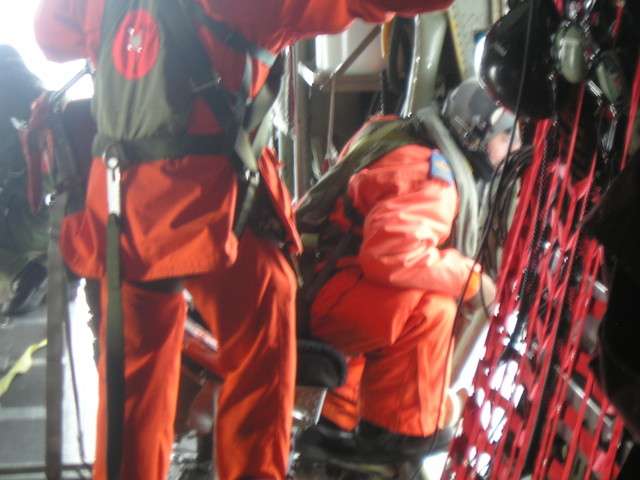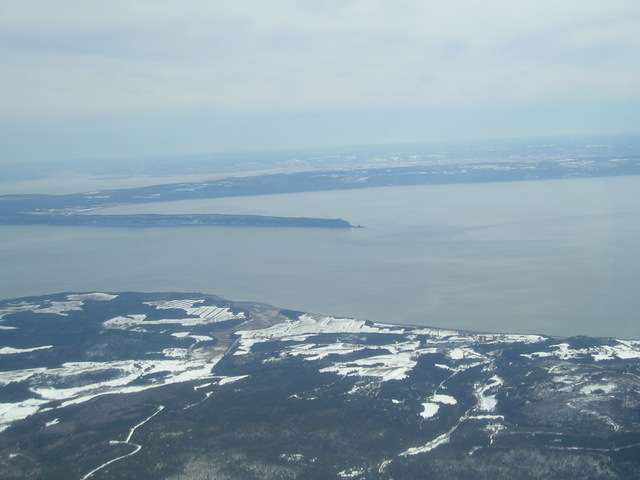Since I've been posted to 14 Wing at CFB Greenwood, my training has prevented me from spending much time on the operational side of the base. Yesterday I had the chance to see what the Air Force does thanks to Captain Leighton James of 413 Search and Rescue Squadron. Leighton is currently doing French Second Language Training with me, and since the language school was closed for spring break this week, Leighton was able to get airborne and invited me along. Leighton is a CF130 Hercules pilot, a native of Dundas, Ontario and like myself an alumnus of the University of Toronto. Friday, March 20th was a gorgeous day for flying. The fligh t's call sign was Tusker 313 - Tusker for
413 Search and Rescue Squadron, which has an elephant on its crest, while 313 is the name of the aircraft (the "Herc" in air force speak).

. Tusker 313 carried the pilot/commander Leighton, two other pilots, a navigator, a loadmaster, three Search and Rescue Tehcnicians (SARtechs) and myself. The purpose of the mission was to conduct training over New Ross at the east end of the Annapolis Valley, then proceed to Nova Scotia's south shore for training with a Coast Guard cutter, and then to the former air force base at Summerside, Prince Edward Island for a parachute drop by the SARtechs, refuelling and lunch. In the afternoon we were to return to Greenwood, do another SARtech jump, and then finish the day. I was a little nervous when Leighton told me that this plane was the response plan for Eastern Arctic and the Maritimes, plus a sizeable chunk of Atlantic Ocean, and could be sent anywhere in this area by the Joint Rescue Coordination Centre in Halifax, possibly for several days - and me without an overnight bag! Oh well, I thought, bash on and hope for the best. Here's the view out of the cockpit window over New Ross, Nova Scotia.

That's Leighton in the co-pilot's seat. He and the two other pilots would regularly trade seats for training purposes. I was allowed to stand behind them as long as I stayed out of the way and didn't snarl the comms cord from my headseat with the others. You can see how bright it was - it got pleasantly warm in the cockpit. Here we are over the South Shore of Nova Scotia, off Lunenburg and Mahone Bay. We rendezvoused with a Coast Guard cutter to begin training for a rescue at sea.

SARtechs at one of the two observation windows in the read fuselage of the plane watch for the target in the water.

The target was an orange disk, 18 inches in diametre, with a flashing strobe in the middle, simulating a person in a floatation device. A very hard target to see in the middle of the ocean. THis was exactly the sort of work that most of this crew had been doing off Newfoundland during the search for the Cougar helicopter that went down off Hibernia. The tail gate of the Herc is opened, to allow a pump to be dropped to a boat in distress. Here the loadmaster supervises the drop and watches for the deployment of the parachute.

Getting ready for the first drop. The gate goes down on the approach to Summerside. That's the Confederation Bridge linking Prince Edward Island to Nova Scotia. It was quite a contrast from the toasty cockpit back here at 3000 feet when the gate goes down!

On the ground at Summerside - Leighton in front of Tusker 313.

On the way home to Greenwood, crossing the Bay of Fundy at 6000 feet. Cape Split, that long curving neck of land, is clearly visible.

 . Tusker 313 carried the pilot/commander Leighton, two other pilots, a navigator, a loadmaster, three Search and Rescue Tehcnicians (SARtechs) and myself. The purpose of the mission was to conduct training over New Ross at the east end of the Annapolis Valley, then proceed to Nova Scotia's south shore for training with a Coast Guard cutter, and then to the former air force base at Summerside, Prince Edward Island for a parachute drop by the SARtechs, refuelling and lunch. In the afternoon we were to return to Greenwood, do another SARtech jump, and then finish the day. I was a little nervous when Leighton told me that this plane was the response plan for Eastern Arctic and the Maritimes, plus a sizeable chunk of Atlantic Ocean, and could be sent anywhere in this area by the Joint Rescue Coordination Centre in Halifax, possibly for several days - and me without an overnight bag! Oh well, I thought, bash on and hope for the best. Here's the view out of the cockpit window over New Ross, Nova Scotia.
. Tusker 313 carried the pilot/commander Leighton, two other pilots, a navigator, a loadmaster, three Search and Rescue Tehcnicians (SARtechs) and myself. The purpose of the mission was to conduct training over New Ross at the east end of the Annapolis Valley, then proceed to Nova Scotia's south shore for training with a Coast Guard cutter, and then to the former air force base at Summerside, Prince Edward Island for a parachute drop by the SARtechs, refuelling and lunch. In the afternoon we were to return to Greenwood, do another SARtech jump, and then finish the day. I was a little nervous when Leighton told me that this plane was the response plan for Eastern Arctic and the Maritimes, plus a sizeable chunk of Atlantic Ocean, and could be sent anywhere in this area by the Joint Rescue Coordination Centre in Halifax, possibly for several days - and me without an overnight bag! Oh well, I thought, bash on and hope for the best. Here's the view out of the cockpit window over New Ross, Nova Scotia.  That's Leighton in the co-pilot's seat. He and the two other pilots would regularly trade seats for training purposes. I was allowed to stand behind them as long as I stayed out of the way and didn't snarl the comms cord from my headseat with the others. You can see how bright it was - it got pleasantly warm in the cockpit. Here we are over the South Shore of Nova Scotia, off Lunenburg and Mahone Bay. We rendezvoused with a Coast Guard cutter to begin training for a rescue at sea.
That's Leighton in the co-pilot's seat. He and the two other pilots would regularly trade seats for training purposes. I was allowed to stand behind them as long as I stayed out of the way and didn't snarl the comms cord from my headseat with the others. You can see how bright it was - it got pleasantly warm in the cockpit. Here we are over the South Shore of Nova Scotia, off Lunenburg and Mahone Bay. We rendezvoused with a Coast Guard cutter to begin training for a rescue at sea.  SARtechs at one of the two observation windows in the read fuselage of the plane watch for the target in the water.
SARtechs at one of the two observation windows in the read fuselage of the plane watch for the target in the water.  The target was an orange disk, 18 inches in diametre, with a flashing strobe in the middle, simulating a person in a floatation device. A very hard target to see in the middle of the ocean. THis was exactly the sort of work that most of this crew had been doing off Newfoundland during the search for the Cougar helicopter that went down off Hibernia. The tail gate of the Herc is opened, to allow a pump to be dropped to a boat in distress. Here the loadmaster supervises the drop and watches for the deployment of the parachute.
The target was an orange disk, 18 inches in diametre, with a flashing strobe in the middle, simulating a person in a floatation device. A very hard target to see in the middle of the ocean. THis was exactly the sort of work that most of this crew had been doing off Newfoundland during the search for the Cougar helicopter that went down off Hibernia. The tail gate of the Herc is opened, to allow a pump to be dropped to a boat in distress. Here the loadmaster supervises the drop and watches for the deployment of the parachute.  Getting ready for the first drop. The gate goes down on the approach to Summerside. That's the Confederation Bridge linking Prince Edward Island to Nova Scotia. It was quite a contrast from the toasty cockpit back here at 3000 feet when the gate goes down!
Getting ready for the first drop. The gate goes down on the approach to Summerside. That's the Confederation Bridge linking Prince Edward Island to Nova Scotia. It was quite a contrast from the toasty cockpit back here at 3000 feet when the gate goes down!  On the ground at Summerside - Leighton in front of Tusker 313.
On the ground at Summerside - Leighton in front of Tusker 313.  On the way home to Greenwood, crossing the Bay of Fundy at 6000 feet. Cape Split, that long curving neck of land, is clearly visible.
On the way home to Greenwood, crossing the Bay of Fundy at 6000 feet. Cape Split, that long curving neck of land, is clearly visible. 


No comments:
Post a Comment